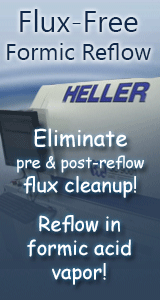NASA Office Of Safety And Mission Assurance
The Office of Safety and Mission Assurance (OSMA) assures the safety and enhances the success of all NASA activities through the development, implementation and oversight of agencywide safety, reliability, maintainability and ...
Research Institute / Laboratory / School
NASA Office Of Safety And Mission Assurance Postings
3 technical articles »
Reliability of PWB Microvias for High Density Package Assembly
Dec 21, 2021 | Reza Ghaffarian, Ph.D.
High density PWB (printed wiring board) with microvia technology is required for implementation of high density and high I/O area array packages (AAP). COTS (commercial off-the-shelf) AAP packaging technologies in high reliability versions with 1.27 mm pitch are now being considered for use in a number of NASA systems including the Space Shuttle and Mars Rovers. NASA functional system designs are requiring ever more denser AAP packages and board features, making board microvia technology very attractive for effectively routing a large number of package inputs/outputs....
Printed Circuit Board Quality: Copper Wrap
Jul 20, 2021 | Jeannette Plante, BhanuSood, Kelly Daniluk
Motivation: High reject rates for PCBs due to specification non-conformances Multiple rebuilds causing impactful schedule delays + Copper Wrap + Wicking + Etchback + Annular Ring Are rejected boards reliable? What are PCB quality requirements for? + Reliability: fewer cycles-to-failure? + Manufacturability: define threshold of modern manufacturing capability?...
A Study on Effects of Copper Wrap Specifications on Printed Circuit Board Reliability
Jul 20, 2021 | Bhanu Sood, John Shue, Jesse Leitner, Kelly Daniluk, Lionel-Nobel Sindjui
During the manufacturing of printed circuit boards (PCBs) for a Flight Project, it was found that a European manufacturer was building its boards to a European standard that had no requirement for copper wrap on the vias. The amount of copper wrap that was measured on coupons from the panel containing the boards of interest was less than the amount specified in IPC-6012 Rev B, Class 3. To help determine the reliability and usability of the boards, three sets of tests and a simulation were run. The test results, along with results of simulation and destructive physical analysis, are presented in this paper. The first experiment involved subjecting coupons from the panels supplied by the European manufacturer to thermal cycling. After 17 000 cycles, the test was stopped with no failures. A second set of accelerated tests involved comparing the thermal fatigue life of test samples made from FR4 and polyimide with varying amounts of copper wrap. Again, the testing did not reveal any failures. The third test involved using interconnect stress test coupons with through-hole vias and blind vias that were subjected to elevated temperatures to accelerate fatigue failures. While there were failures, as expected, the failures were at barrel cracks. In addition to the experiments, this paper also discusses the results of finite-element analysis using simulation software that was used to model plated-through holes under thermal stress using a steady-state analysis, also showing the main failure mode was barrel cracking. The tests show that although copper wrap was sought as a better alternative to butt joints between barrel plating and copper foil layers, manufacturability remains challenging and attempts to meet the requirements often result in features that reduce the reliability of the boards. Experimental and simulation work discussed in this paper indicate that the standard requirements for copper wrap are not contributing to the overall board reliability, although it should be added that a design with a butt joint is going to be a higher risk than a reduced copper wrap design. The study further shows that procurement requirements for wrap plating thickness from Class 3 to Class 2 would pose little risk to reliability (minimum 5 μm/0.197 mil for all via types).Experimental results corroborated by modeling indicate that the stress maxima are internal to the barrels rather than at the wrap location. In fact, the existence of Cu wrap was determined to have no appreciable effect on reliability....






